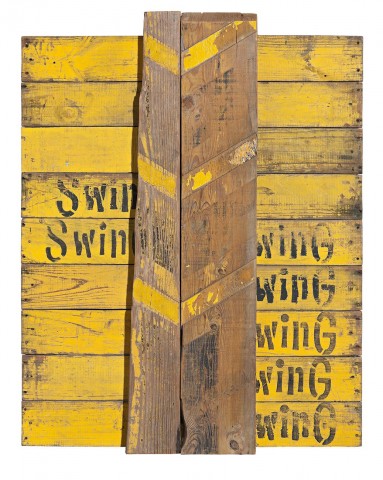HONEY FLOW, 1985
ROSALIE GASCOIGNE
painted and stencilled wood, nails on plywood backing
108.0 x 84.0 x 7.0 cm
signed with initials, dated and inscribed with title verso: HONEY FLOW / 1985 R.G.
Collection of the artist, Canberra
Thence by descent
Private collection, Canberra
Rosalie Gascoigne 1985, Fine Arts Gallery, University of Tasmania, Hobart, 8 – 28 September 1985, cat. 3 (illus. in exhibition catalogue)
Rosalie Gascoigne, Pinacotheca, Melbourne, 15 October – 1 November 1986, cat. 1
From the Studio of Rosalie Gascoigne, Drill Hall Gallery, Australia National University, Canberra, 5 September – 8 October 2000, cat. 17
Macdonald, V., Rosalie Gascoigne, Regaro, Sydney, 1998, p. 106
From the Studio of Rosalie Gascoigne, exhibition catalogue, Drill Hall Gallery, Australia National University, Canberra, 5 September – 8 October 2000, p. 62
Gascoigne, M., Rosalie Gascoigne: A Catalogue Raisonné, ANU Press, Canberra, 2019, cat. 275 (forthcoming catalogue)
We are grateful to Martin Gascoigne for his assistance with this catalogue entry.
My grandmother came to art late. Rosalie Gascoigne was 57 when she had her first solo exhibition, but once there discovered it was her natural calling. By 1974, what had started for her as flower arranging had grown into a unique artistic practice. It did not take long for her assemblages of found materials to be recognised across the globe. In 1982 she was the first woman to represent Australia at the Venice Biennale and ten years later she was awarded the Order of Australia for her services to the arts. Her work is held in all major Australian public collections, the Metropolitan Museum of Art in New York, the Tate Gallery in London and the Museum of New Zealand Te Papa Tongarewa.
From the beginning Gascoigne took her cue from nature, seeking materials that evoked their own story.
Although flashes of yellow had appeared throughout her earlier assemblages, Honey Flow, 1985 was the first to be constructed solely of yellow boards. Works that she registered as 'firsts' were important to Gascoigne, who liked to keep them to herself. Honey Flow, a work that heralded a legendary series of yellow assemblages,1 hung on her living room wall for years and remained in her possession all her life. Yet to me Honey Flow is more than the first in a series. I see it as expressing Gascoigne’s nature – its flow is the current that runs through all her significant work.
The materials – signboards for soft drink boxes and two street barricades – came out of Gascoigne’s past work and would lead into the work to come. Here she literally unpacks the boxes that had formed the frame and foundation of her earliest assemblages from the 1970s onwards.2 The work's tripartite organisation is columnar – a form that ran through her art from first to last (people always talk about the grid but I think she favoured the column3). The dismantled box-boards are arranged like ladders, some with lettering that is a visual riff of short repeated words, ‘swing’ and ‘wing’, reminiscent of a refrain in music. Finally, and decisively, she ran two bold lengths of retro-reflective road barricade down the centre: the retro-reflective a sign of things to come.4
Honey Flow shines with the shamanistic blaze that Gascoigne was able to summon from her materials. The blaze doesn't relate to transcendence. Quite the opposite. It signifies a reduction. Just as it is a bee’s instinct to collect pollen to make honey, here one gets the sense of wood declaring its essential ‘wood-ness’. The heavy central panels drag down the horizontal flow of the fanning side columns. The three Vs sink down and spread outwards in a play of weight versus movement, (Gascoigne had admired those qualities in paintings by Pablo Picasso such as Deux femmes courant sur la plage, 1922). Looking at the work one has an almost physical sensation of the gentle warmth of wood and the viscous flow of honey – it is Gascoigne’s poetry that connects the two. Grandmother was a firm believer in the fact that one cannot escape one’s natural calling. She explained it to me, and to many others: ‘I’m an artist, it’s just the sort of animal I am’. Honey Flow is the natural product of the artist animal, working as naturally with her materials as a bee with pollen.
1. Including the monumental works Monaro, 1989 (Art Gallery of Western Australia, Perth), Plenty, 1987 (National Gallery of Australia, Canberra) and Great Blond Paddocks, 1998 – 99 (Art Gallery of New South Wales, Sydney).
2. Works such as Enamel Ware, 1974, Italian Birds, 1975, Boxers, 1976 etc.
3. See for example Rain forest, 1980, Sharpe Bros horizontal, 1979/1980 – 81, Scrub Country, 1981 – 82, Spring 1 and Spring 2, 1981-82, and String of Blue Days, 1984.
4. See for example Highway Code, 1985, Tiger Tiger, 1987 and Metropolis, 1999.
HESTER GASCOIGNE
